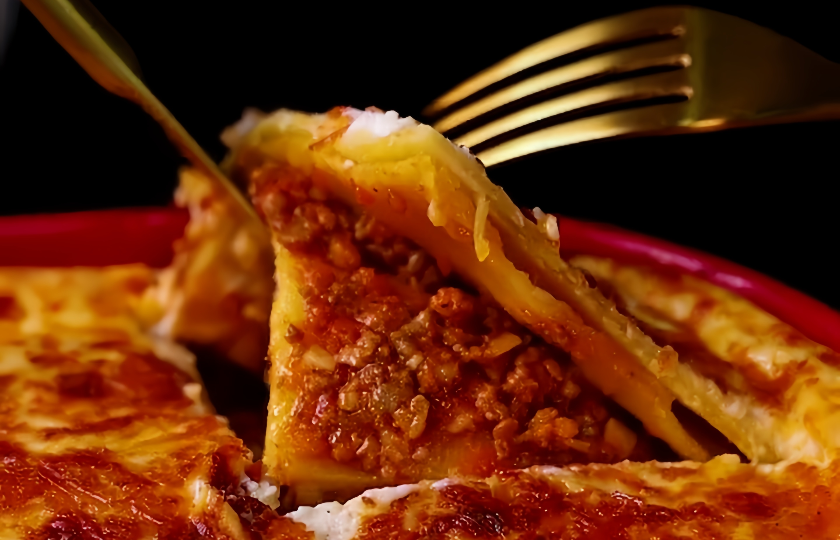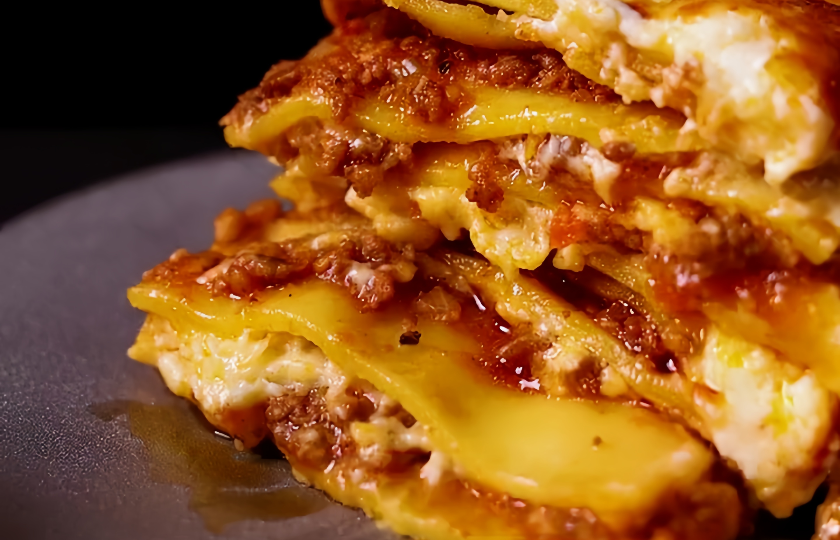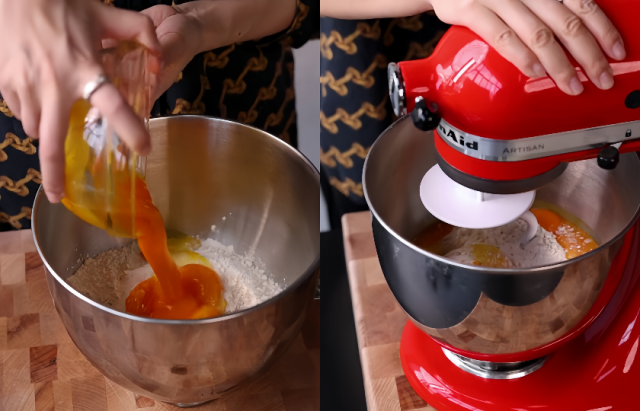Christmas Lasagna For Beginners

On the Christmas dining table, a plate of steaming lasagna can warm people's hearts the most. The delicious layers upon layers emit an alluring aroma, adding warmth to the holiday dinner.
Required raw materials and substitutes
Main ingredients
Flour: The basis for making pasta sheets, providing toughness and layering to the dough.
Eggs: Add toughness to the dough and enhance the taste and nutritional value.
Milk: Used to make the White Soup sauce to make the taste more delicate and rich.
Meat sauce: Provides a salty and fresh taste and is an important source of layering.
Accessories
Butter: The basis for making the White Soup sauce, bringing a rich milky aroma.
Parmesan cheese: Adds milky aroma and a salty and umami taste, enhancing the layering.
Seasonings
Salt: Season and enhance freshness, balancing the overall taste.
White pepper: Adds a mild spicy fragrance and enhances the layering.
Substitutes
Flour: Can be replaced by high-gluten flour for a more resilient taste.
Butter: Light cream can be used as a substitute, but the aroma is slightly weaker.
Parmesan cheese: Other hard cheeses can also be substituted.
Milk: Diluted light cream can be used as a substitute for a richer taste.
Meat sauce: Beef sauce or vegetarian meat sauce can be selected as an alternative.

Is lasagna for Christmas a thing?
Eating lasagna on Christmas is indeed a common thing. Lasagna is indeed one of the traditional delicacies on the Christmas dining table and is particularly popular in Italy and many Western countries.
There are several reasons for choosing lasagna during Christmas. First of all, it is a large portion of food that can be prepared in advance and is suitable for family gatherings. Secondly, the layered shape and golden appearance have a festive atmosphere.
Most importantly, it is rich in nutritious ingredients such as cheese and meat sauce, and can provide sufficient heat in the cold winter.
Secrets of success
Making pasta sheets: When stirring the batter, it should be fully beaten to ensure there are no particles. When rolling out the pasta sheets, the thickness should be uniform. It is recommended to control it within 2-3 millimeters. If it is too thick, it will affect the taste. If it is too thin, it is easy to break. It is best to make the pasta sheets one day in advance. After proofing, they will be more resilient and will not break when boiled.
Making White Soup sauce: The ratio of butter to flour should be 1:1. When frying, the heat should be high to avoid gelatinization of the flour. When adding milk, it should be added in 3-4 times. Each time, it should be fully stirred evenly before adding the next time. This can avoid lumps. When adding cheese at the end, the sauce temperature should not be too high to avoid excessive melting of the cheese and loss of taste.
Baking skills: Place each layer evenly. Put a little more White Soup sauce on the edges to prevent drying out during baking. When baking, it is recommended to cover with tin foil for the first 20 minutes and then remove the tin foil for the last 20 minutes. This can ensure that the inside is fully heated while the surface is golden just right. Let the finished product stand for 10 minutes before cutting into pieces to keep the shape intact.
What makes lasagna taste better?
Selection of high-quality ingredients: Use durum wheat flour to make pasta sheets for a more resilient taste; use whole milk and high-quality Parmesan cheese to make White Soup sauce to enhance the milky aroma; you can mix beef and pork to make meat sauce for a richer taste; add fresh Italian herbs such as rosemary and thyme to add aroma.
Seasoning and enhancing fragrance: Adding a pinch of nutmeg powder to the White Soup sauce can highlight the milky aroma; an appropriate amount of red wine can be added to the meat sauce to enhance the layering; sprinkle different types of cheese on each layer, such as a mixture of mozzarella, cheddar and Parmesan, to create a rich cheese flavor.
Cooking skills: Boil the pasta sheets until they are 70% cooked to retain toughness; keep the White Soup sauce delicate and smooth; sprinkle more cheese on the last layer and bake until golden; let it stand for 15 minutes after coming out of the oven before cutting into pieces to allow the soup to fully penetrate and the taste will be more intense.
INGREDIENTS
Main Ingredients
-
·450g flour
-
·6 eggs
-
·500ml milk
-
·200g meat sauce
Additional Ingredients
-
·200g butter
-
·10g parmesan cheese
Seasonings
-
·3g salt
-
·3g white pepper powder
COOKING STEP
Step 1
Pour 250 grams of flour into a container, add 6 eggs, and fully stir evenly with a mixer to form a batter.

Step 2
Knead the stirred batter vigorously into a dough, and then roll it into thin slices with a pasta machine, keeping the thickness uniform.

Step 3
Cut the pasta sheets according to the size of the baking pan. Prepare five pasta sheets of the same size and set aside.

Step 4
Make White Soup sauce: Put 200 grams of butter in a pot and melt it. Add 200 grams of flour and quickly stir evenly.

Step 5
Add 500 milliliters of milk in several times, keep stirring continuously until the liquid is thick and smooth without flour particles.

Step 6
Add 3 grams of salt, 3 grams of white pepper powder and 10 grams of shredded Parmesan cheese to the White Soup sauce and stir evenly.

Step 7
Brush a layer of White Soup sauce on the bottom of the baking pan, and then lay pasta sheets, meat sauce and Parmesan cheese in sequence to form a base layer.

Step 8
Repeat the above placement steps, pay attention to evenly distributing the materials on each layer until all materials are used up.

Step 9
Sprinkle an appropriate amount of Parmesan cheese on the last layer. Pay attention to controlling the overall height to be nine-tenths full of the baking pan.

Step 10
Put it into a preheated oven and bake at 180 degrees for 40-45 minutes until the surface is golden and crispy.

More recipes worth trying
Festive Treat Italian Cookie Recipes For Christmas
Authentic Sichuan Delicacy: Sweet Noodles
Storage instructions
Storing lasagna in the refrigerated compartment at 4 degrees in a household refrigerator is the most suitable. Generally, the taste can be maintained for 3-4 days. Before storage, the food must be completely cooled. Generally, during the time from after dinner to before going to bed, the appropriate temperature can be reached.
The best consumption period of lasagna is within 48 hours after baking. After this time, the pasta sheets will become soft and the taste will significantly decline. Making an 8-inch portion at one time. A family of three can usually finish it within two days, which not only ensures freshness but also avoids waste.
Serving Suggestions
Main meal pairing: Lasagna needs to be paired with Italian bread and fresh vegetable salad. Dipping bread in the overflowing meat sauce and White Soup sauce is especially delicious. For the salad, it is best to choose a combination of purple cabbage, lettuce, and cherry tomatoes, and drizzle with lemon juice or Italian vinaigrette.
Beverage recommendation: Dry red wine is the best pairing. The tannins in wine can well neutralize the greasiness of cheese. If you dont drink alcohol, you can choose an apple cider vinegar drink with lemon slices added, which can both relieve greasiness and help digestion.
Eating tips: The best eating temperature for lasagna is 50-60 degrees Celsius. At this time, the aroma of cheese is the strongest. When cutting into pieces, cut vertically from top to bottom to maintain distinct layers. When eating, insert a fork slightly forcefully to ensure that every bite can have the perfect combination of pasta sheets, meat sauce and cheese.
FAQs:
Mozzarella cheese is the most ideal choice. After melting, there will be a beautiful stretching effect. When eating, gently lift with a fork. The picture of golden filamentous cheese being slowly pulled up is very tempting.
Cheddar cheese can bring a more intense flavor and is especially suitable for people who like strong flavors. During production, Cheddar cheese can be grated and sprinkled on the surface of each layer. After baking, it will form an attractive golden color.
The control of heat directly affects the quality of the White Soup sauce. Use medium heat when cooking the flour. When a faint milky fragrance appears, it is time to add milk.
In the milk boiling stage, be sure to turn to low heat and simmer slowly. At this time, you can prepare other ingredients while watching the pot and stir once every minute. When small bubbles start to appear in the White Soup sauce in the pot and you can see traces of slow flow when stirring with a spoon, this is the best state.
The main functions of greasing are to prevent sticking and add flavor. An ungreased baking pan will cause the bottom pasta sheet to stick. Not only will it affect the appearance, but it will also be easy to damage the layers when taking it out. By brushing a thin layer of oil on the bottom and sides of the baking pan, the pasta sheet will not stick, and the finished product can be easily taken out intact, and the edges will also be baked golden and crispy.

















